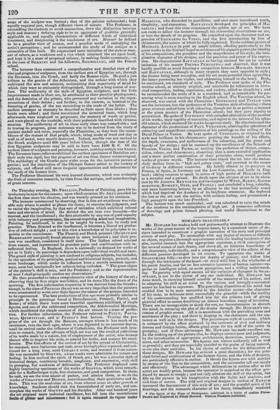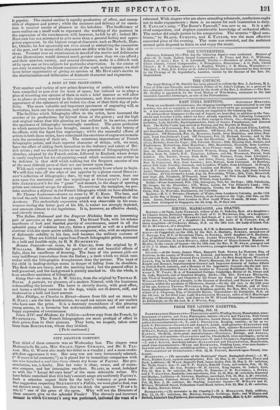HOWARD'S SHAKSPEARE.*
Mr. HOWARD has made a bold and praiseworthy attempt to illustrate the works of the great master of the human heart, by a connected series of de- signs intended to constitute a graphic narration of the story and principal events of each play. To accomplish with any degree of success so difficult an object, requires a thorough acquaintance with the leading incidents of the plot, careful research into the appropriate costumes, a vivid conception of the several scenes of each drama, and above all, an intimate knowledge of the characters, individually, and a comprehensive view of the effects of the different passions developed in its course. To appreciate the works of SHANSPEARE fully—to dive into the depths of passion, and follow him through the intricacies of the heart—to revel with him in the witcheries of his poetic fancies, and the no less eccentric humours of human nature—re- quires an intelligent mind, an acute perception, and a willing understand.. ing. To portray with equal success all the varieties of character in SHAK- SPEARE, is not in the power of any one individual. Mr. Howaso has done much, in showing himself sensible of the meaning of his author, and in adapting his skill as an artist to the various and strongly-contrasted scenes be has had to represent. The prevailing disposition of his mind has enabled him to be most successful in the familiar scenes—the character of his taste, to delineate most successfully the graceful—while the docility of his understanding has qualified him for the arduous task of giving pictorial effect to scenes describing an almost boundless range of invention. There are no incongruities to shock the eye, no inconsistencies to disturb the mind, in retracing the plot of the drama through Mr. }Iowans:Os suc- cession of graphic scenes. All is in accordance with the prevailing tone and sentiment of the play ; and there is keeping in the characters and the cos- tumes as well as in the designs. The picturesque style of costume, which is enhanced by the effect produced by the contrasts of civil and military dresses and foreign habits, affords great scope for the skill of the artist in grouping; and of these advantages Mr. HOWARD has made excellent use. In the making up of the picture also, he displays correct taste and judgment, by the introduction of appropriate architecture, decoration, scenery, orna- ment, and other accessories. His figures are almost uniformly tall as well as graceful ; and they are especially entitled to the praise of being natural, as are also their attitudes. In his cboice of outline for the delineation of these designs, Mr. HOWARD has evinced a good discretion ; for the prin- cipal forms and combinations of the human figure, and the folds of drapery, are particularly effective in outline. It blends the figures one with another by means of the line in the composition, and the accessories tell out neatly and effeCtively. The advantages which delineations in outline offer to the artist are doubly great, because the spectator is surprised at the effect pro- duced by means so simple ; and not only admires the skill of the artist, but fills up the picture in his imagination with the lights and shadows, and rich hues of nature. The wild and original designs in outline of RETSCH increased the fascinations of this style of art ; and the graceful spirit of his drawings, and the romantic character of his fancy, immediately rendered * The Spirit of the Plays of ShaksPeare, exhibited in a Series of outline Plata& Drawn and Engraved by Frank Howard. Sixteen Numbers Published. it popular. The shaded outline is equally productive of effect, and suscep- tible of elegance and power ; while the neatness and delicacy of its execu- tion is another source of pleasure to the beholder. The inefficiency of mere outline on a small scale to represent the working of the passions in the expression of the countenance, will, however, be felt by all ; indeed Mr. HOWARD has not attempted to give more than a general feeling and appro- priate expression. In the highest range of character, such as Macbeth, Ham- let, Othello, he has apparently not even aimed at embodying the conception of the poet, and in many other characters we differ with him in his idea of them. To enter into an examination in detail of the merits and deficiencies of the illustrations, would demand much greater space than we can afford ; and their number, variety, and general cleverness, make it a difficult task td fix upon one or two subjects for particular observation. In the course of our duty in noticing the haul?, numbers of the work as they appear, we shall have better opportunity of giving an opinion of Mr. HOWARD'S merits in the discrimination and delineation of dramatic character and expression.



















 Previous page
Previous page